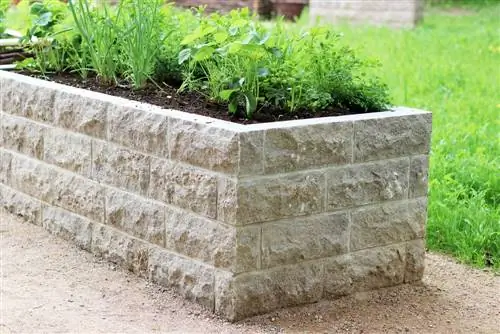- Author admin [email protected].
- Public 2023-12-17 03:39.
- Last modified 2025-06-01 06:48.
Winter means darkness means lighting - also around the house and garden. But how should you operate the system? When is it worthwhile to use a solar system? We explain how to assess needs and possibilities.
Different season - different focus
Although your garden is of course still the same outside of the flowering and harvest-heavy seasons, the way it is used and therefore also the way you illuminate it and all of your outdoor areas change. While in summer, sitting comfortably in the countryside is made even more pleasant with subtle lighting, in winter the focus is on a completely different lighting:
House lighting
Around your house, the main thing is to ensure the safe usability of access and paths, for example to the house, the garage or even the bicycle shed. Because the days are much shorter, the number of uses in the dark increases enormously. Typical lighting variants are:
- Spotlights, often in conjunction with motion detectors
- Accompaniment lights on paths
- Spots or point lights under canopies or next to entrance doors
Garden lighting
In the garden, however, the lighting of paths, for example to the compost heap, is also important. In addition, two other areas of application are much more important here:
Decoration
Whether as a replacement for the missing greenery, or for special occasions such as Christmas or New Year's Eve - light creates joy and a pleasant atmosphere. In addition to decorative individual lights, fairy lights or other decorative installations that are now mostly LED-based are widely used.
Plant lights
At the end of winter at the latest, it's also about preparing for the upcoming growth and planting period. In greenhouses, the first sprouts can be grown shortly after the turn of the year under special lighting that imitates and replaces the missing sunlight.
The solar system - makes sense in winter?
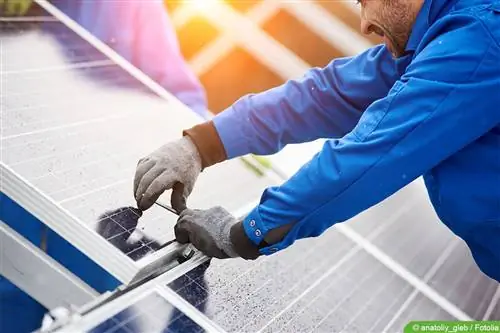
Where you have an almost unmanageably large number of options available when choosing individual lighting elements and lamps, when it comes to the question of the power supply for your lighting, there are only two common variants:
The mains power supply
Of course, you can connect all lamps to the power supply in your home in the usual way. All that is required is cables to the distributor and possibly another sub-distributor with separate protection for the garden. Sometimes outdoor and garden lighting can also be connected easily and with little effort via the garage or shed supply.
The photovoltaic system
If you generate your electricity yourself using a photovoltaic system, you can of course also use the electricity yourself, for example for your home lighting and your garden. Here, too, you need a line infrastructure for the supply, but using your own electricity has a positive impact on your account.
Or not?
To find out exactly that, you can first use a simple rough calculation to determine whether your system produces enough electricity in winter. A second step then clarifies very simply whether this approach is economical.
NOTE:
In the following analysis we assume a so-called island system that generates electricity and stores it via a battery. They are used primarily for gardens, holiday homes and other limited uses. Please do not confuse an island photovoltaic system with a photovoltaic system permanently installed on the roof of your house to feed into the grid. Here, both yield and acquisition costs are much higher.
The calculation example
First of all, you need some basic parameters in the form of the power of your lamps as the basis for every calculation. Ideally, you can take it from your specific consumers. For this example, however, we use common average values:
- LED light accompanying the path or individual light, approx. 6 watts each
- Spotlight or spot, averaged as a mixed use of LED and other technology, approx. 25 watts each
- Classic wall or ceiling light, approx. 25 watts each
- Decorative lighting as a chain of lights, 200 LEDs, each chain approx. 60 watts
- Plant lights, approx. 100 watts each (surface spotlight)
- Plant lights, approx. 12 watts each (single spotlight)
Your consumption
Unfortunately it is not enough to simply add up your consumers and determine the performance. Ultimately, it is not the pure power consumption of your lighting that is of interest, but rather the total consumption within a period of time, in this case within a day. Therefore, you now have to assign time periods to your individual lights in order to go from the output in watts (W) to a power consumption per time in watt-hours (Wh).
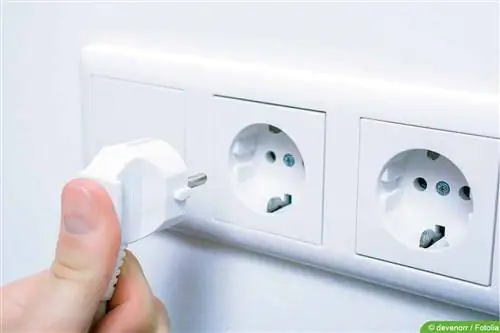
The lights listed again represent an example, which you should of course replace with your actual types and quantities of lights:
- Path lighting 6 W, 8 pieces, operating time in the evening 6h=288 Wh
- Spotlights 25 W, 2 pieces, operating time via motion detector each 0.5h=25 Wh
- Wall light 25 W, 1 piece, operating time approx. 2h=50 Wh
- Light chain 60 W, 2 pieces, operating time overnight 12h=1,440 Wh
- Plant light 12 W, 3 pieces, all day=432 Wh
Results in a currentTotal consumption for lighting of 2,235 Wh.
So your daily electricity consumption for garden lighting and house lighting is around 2.2 kilowatt hours (kWh)
Collector area and current yield
Now that you know how much electricity you use, it's time to generate it. Since you only know your consumption so far, but don't yet know how big the associated solar system has to be, we're calculating backwards at this point.
In winter you must assume that the yield of a photovoltaic system does not correspond to the standard of a bright summer day due to short daylight phases, bad weather and generally lower solar radiation. As a calculation value, assume a maximum yield of around 30% of the summer peak output.
That means:
Daily consumption 2.2 kWh / percentage yield 0.30 (=30%)
=7.3 kWh target daily output of the system
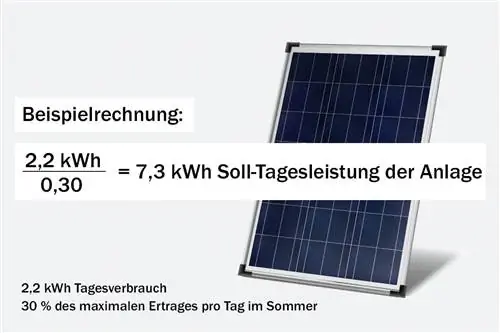
Using this calculation result, you can now find out from the providers of island photovoltaic systems which system delivers the desired yield. Depending on the manufacturer, an island system with an output of 1,500 watts and a total daily output of 7 to 8 kWh per sunny day would be the right choice. The collector area required for this is around 10 square meters, which can easily be accommodated on a garage or shed roof.
As you can see, from a technical point of view, the electricity consumption of your system can be easily covered by a solar system.
The economic perspective
The second question is about the economic viability of such a constellation. Here, too, we first create some assumed basic values in order to then use them for a simple profitability calculation:
- Acquisition costs for solar system 1,500 watts as a complete system including storage and installation material approx. EUR 2,700
- Consumption price per kilowatt hour from the public power grid approx. 0.35 EUR (depending on provider, tariff and total consumption)
- Other installation costs for power lines for lighting=0.00 EUR (as costs anyway, even necessary with mains supply)
This is how we getElectricity costs per day (total consumption 2.2 kWh x 0.35 E / kWh) of 0.77 EUR.
Electricity costs per winter phase (assumed November to March, i.e. 5 months with an average of 30 days each): 0.77 EUR x 150 days=115.50 EUR
If you now look at your winter lighting situation alone, you will come to the conclusion that the costs of your photovoltaic system will be covered by the electricity saved after around 23.5 years.
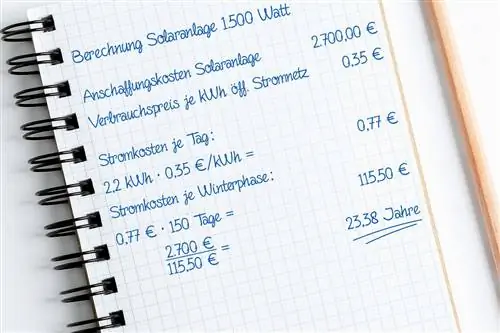
If you now go one step further and assume winter consumption as the year-round average consumption, the payback period is reduced enormously.
When operating 365 days a year, you save 365 days x 0.77 EUR=281.05 EUR / year with constant consumption. According to this consideration, the solar elements generate their own income after just over 9.5 years.
ATTENTION:
Despite intense winter lighting, expect significantly higher summer consumption from pumps etc.out of. Since the yield is significantly higher in summer, the realistic payback period for your system is likely to be even lower than the roughly estimated value of almost 10 years.
The consideration - solar system or not?
Ultimately, you have to decide for yourself whether using a solar system to supply your lighting in winter is actually an option. However, using this simple calculation example, you can quickly determine how quickly such a system will pay off in your specific case.
Assume that 10 to 15 years of operation will not be a problem before the solar modules significantly lose their performance. If you want to be on the safe side, the manufacturers of these systems often support you with much more detailed calculations of consumption and payback periods to support your decision-making.


